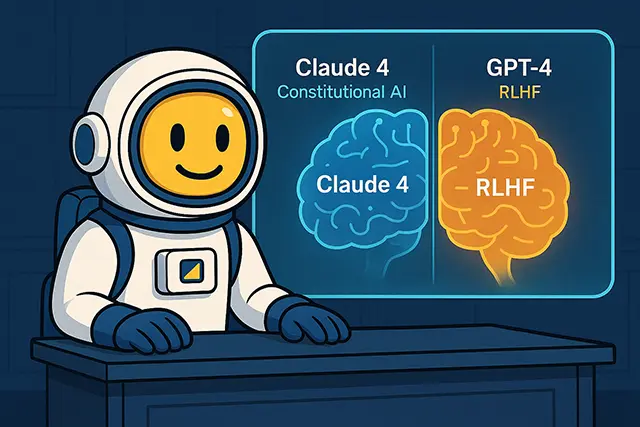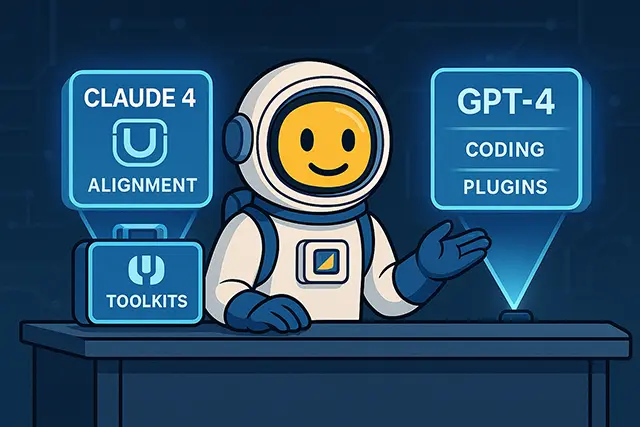Claude 4 vs GPT-4 – A Deep Dive Into Their AI Training Philosophy

Claude 4 vs GPT-4 is more than a comparison of two powerful language models it’s a reflection of two competing philosophies in artificial intelligence. As AI becomes embedded into everything from customer service to creative writing, the debate now centers on trust, alignment, and long-term safety not just performance.
Two of the leading models in this space OpenAI’s GPT-4 and Anthropic’s Claude 4 represent distinct answers to a central question: how should we train artificial intelligence? While both are cutting-edge in capability, their creators took very different paths in how those capabilities were developed and governed.
Understanding that divergence matters. Whether you’re a developer integrating AI into enterprise software, a researcher concerned about AI safety, or a startup founder selecting a foundational model, knowing how GPT-4 and Claude 4 think differently is crucial to how you’ll use them.
Table of Contents
Company Origins & Philosophies
OpenAI’s Reinforcement Learning from Human Feedback (RLHF)
OpenAI’s foundational training philosophy revolves around RLHF Reinforcement Learning from Human Feedback. The model is trained to generate responses, and then human annotators score those responses based on helpfulness, safety, and accuracy. The model learns to optimize its behavior to earn higher scores.
This technique, which helped push GPT-3.5 and GPT-4 to mass adoption, works well for guiding models toward general behavior that aligns with what humans want. But RLHF is also deeply human-dependent it inherits the biases and blind spots of its raters. And while it improves short-term performance, it’s not always scalable or principled.
Anthropic’s Constitutional AI
Anthropic, founded by former OpenAI employees concerned with long-term alignment, took a very different route. Instead of relying solely on human ratings, Claude 4 is trained to critique and revise its own outputs based on a fixed set of principles its constitution.
This approach gives the model a more transparent and rule-based framework for decision-making. If a user prompt violates ethical standards or suggests harmful behavior, Claude doesn’t just block the response it explains why, using its internal guidelines. We explored this in more detail in our breakdown of what Constitutional AI actually means, and why it matters for safe and scalable LLMs.
While OpenAI’s model reflects human preferences, Claude reflects encoded ethical reasoning.
Training Data and Methodology
GPT-4: Closed, Scaled, and Proprietary
OpenAI has remained extremely private about GPT-4’s training architecture. We don’t know the number of parameters, the full size or content of its dataset, or whether it’s a single model or a mixture of experts. This has frustrated many in the research community but is consistent with OpenAI’s current commercial orientation.
What we do know is that GPT-4 was trained on a massive dataset using scaled compute infrastructure, with an emphasis on broad generalization, coding tasks, and multilingual fluency. It excels in areas where performance benchmarks can be measured quantitatively.
Claude 4: Transparent, Process-Oriented
Claude 4’s training process is a bit more open. While Anthropic also keeps some technical details private, they have published papers on their methods and alignment approach. Their focus isn’t on parameter count but on training philosophy particularly how the model learns to reflect on its own answers and improve them.
Claude’s learning is augmented by internal feedback loops, where the model critiques its own outputs in light of its constitution. This makes it more resistant to blind repetition and more likely to include rationales for its answers. For those interested in interpretability and AI behavior, Claude’s training approach offers a more accessible entry point.

Alignment Strategies Compared
RLHF: Effective but Labor-Intensive
Reinforcement Learning from Human Feedback has one major strength: human intuition. The model learns to mimic what people like, which works well for polite conversation, humor, and creativity. But it’s also labor-intensive, costly, and increasingly difficult to scale. As the models grow, the number of edge cases explodes and humans can’t keep up.
RLHF also suffers from inconsistency. Annotator instructions vary, and bias is baked into every rating. While OpenAI has tried to minimize this with instruction tuning and preference modeling, the cracks show when GPT-4 is pushed into complex moral or political topics.
Constitutional AI: Principled and Self-Correcting
Claude 4 uses a predefined set of principles things like “be helpful,” “don’t support violence,” and “respect user privacy.” After generating an initial output, the model then critiques itself using these guidelines. If the output violates a principle, it revises the response and explains why.
This is what makes Claude feel more thoughtful in practice. It’s not just outputting what it thinks you want it’s checking its work. This internal discipline has made Claude notably more resilient against harmful prompt engineering and jailbreak attempts, something we covered in our guide to Claude’s prompt safety features compared to GPT.
It’s not perfect, of course. Claude can still hallucinate or miss nuance. But the mechanism for catching those errors is built in, rather than bolted on.
Safety and Jailbreak Resistance
GPT-4’s Guardrails Are External
OpenAI uses a layered safety system for GPT-4, including moderation APIs, classifiers, and filtered outputs. While effective at a surface level, these systems can sometimes feel abrupt or inconsistent. Users have reported vastly different results to the same prompt, depending on phrasing.
GPT-4’s defenses are mostly external. The model isn’t aware that a request might be harmful it’s just trained to avoid outputs that were previously rated poorly. This makes it vulnerable to subtle variations or adversarial phrasing.
Claude 4’s Safety Is Internal
Claude’s safety mechanisms are built into its reasoning process. It doesn’t just refuse a prompt; it explains the refusal. It shows the line it won’t cross and why.
This is powerful in regulated industries or public-facing applications, where users or auditors may need to understand why a model responded the way it did.
It also makes Claude more consistent. While no model is jailbreak-proof, Claude’s approach makes it significantly harder to exploit and easier to understand when something goes wrong.
Claude 4 vs GPT-4 – Performance and Use Cases
Claude 4 for Language and Reasoning
Claude excels in long-context tasks document summarization, tone control, and ethical analysis. Its internal critique mechanisms make it well-suited for workflows where consistency and transparency are key. That’s why many writers, policy analysts, and educators prefer Claude when they need their content to sound polished, nuanced, and aligned. You can read more about this in our piece on Claude 4’s capabilities for writers and editors.
GPT-4 for Code and Plugins
GPT-4 continues to dominate in areas like code generation, reasoning puzzles, and complex API integrations. Its plugin ecosystem is also more mature, making it easier to extend into vertical-specific tasks like scheduling, calculations, or document creation.
For teams that need speed, raw flexibility, and broad language coverage, GPT-4 remains the go-to. Its versatility is unmatched but its outputs sometimes require more moderation or manual checking.
Transparency & Ethics
GPT-4: Opaque by Design
OpenAI no longer provides parameter counts or architectural details. The training data is private. The safety methods are proprietary. While this secrecy is justified by competition and safety concerns, it leaves developers and researchers guessing about how GPT-4 works under the hood.
This opacity becomes a liability in high-stakes scenarios. If you’re building legal tools or medical advisors, you need more than accuracy you need explainability.
Claude 4: Transparency by Default
Claude makes its internal process visible. When the model revises an answer, it often includes a comment like, “Upon review, this response may not fully align with the principle of non-harm.” This builds trust and enables developers to see not just the output, but the reasoning behind it.
That transparency pays off in sensitive domains, where compliance and accountability are more important than cleverness.
Developer Experience and APIs
GPT-4’s Tooling Ecosystem
OpenAI has built a robust developer platform, complete with plugins, Assistants API, Whisper integration, and file handling. If your team already builds on OpenAI’s stack, GPT-4 offers an expansive toolset and detailed documentation.
Claude’s Developer Transparency
Claude may not yet offer plugin-style extensibility, but its APIs are clean, stable, and geared toward enterprise integration. More importantly, it outputs justifications that can be parsed, logged, or audited an underrated feature for risk management.
For teams building AI layers into their own apps, Claude’s explainability gives a long-term advantage. We highlighted some of the best tools and methods for using Claude’s APIs in our guide to Claude 4 developer tools.
Claude 4 vs GPT-4 – Which One Is Right for You?
Claude 4 Is Ideal For:
- Teams working in compliance-heavy fields like finance, law, and healthcare
- Writers and educators who need refined, ethically-grounded outputs
- Developers who value transparency and built-in safety
GPT-4 Is Best For:
- General-purpose AI applications with performance as a top priority
- Coding tools, multi-modal plugins, and broad content generation
- Fast-moving startups looking for quick iteration
But you don’t necessarily need to choose. Many developers are using both models in parallel, routing sensitive tasks to Claude and general ones to GPT. Hybrid stacks are becoming more common, and understanding each model’s strengths makes those stacks more powerful.
Final Verdict
Claude 4 and GPT-4 represent two visions of artificial intelligence not just in performance, but in purpose.
GPT-4 was built to do more. Claude 4 was built to do better.
In the race to scale AI, OpenAI leaned on volume, data, and reward tuning. Anthropic leaned on alignment, philosophy, and reflection. Both models deliver stunning capabilities, but Claude’s internal ethical framework makes it uniquely suited for tasks where human values matter as much as human language.
If you want power, GPT-4 delivers. If you want principles, Claude is the safer bet.
And if you want to understand Claude’s constitution-driven architecture more deeply, you can start with our main breakdown of Claude 4 by Anthropic where all of this begins.



